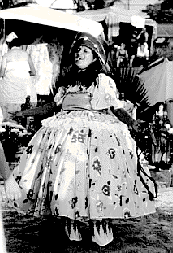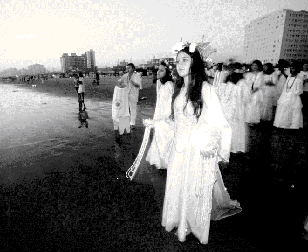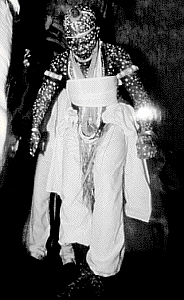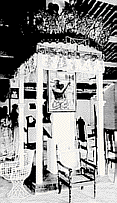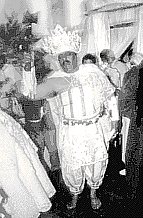 |
The cross at the crossroads
text and photos by Roderick Steel
| Umbanda |
 |
| |
| Brazil was the last country in the world to abolish slavery. Originally brought in to replace Indians thought to be too weak, the Portuguese shipped in an estimated 3.6 million Africans to Brazil over four centuries. Joaquim Nabuco, in O Abolicionismo, blamed Brazil's inadequate development as a nation on the culture of slavery and racism. |
 |
First arrivals came from the Congo, Angola and Mozambique in 1570. They were so cheap that even impoverished colonos from Bahia and Pernambuco were able to afford them. Known as "Negros Bantos", they worshipped ancestor spirits (Inkices), and were spread along the coast of Maranhão, Pernambuco, and Rio de Janeiro. Many of these slaves managed to escape, and lived in communities in seclusion (kilombos). Slaves also came into contact with Indian elders and witch doctors (pajés) and took part in spirit sessions where they received both Indian and African ancestor spirits. A sacred bond was formed in the heart of the forest by these two cultures. Indians showed the Africans their gods, taught them their myths, and in return, Africans shared knowledge on medicinal herbs, and summoned spirits the Indians had never seen or heard about. A vast array of Brazilian religions pay homage to this bond - catimbó, pajelança, jurema, toré, encantaria, tambor-de-mina. Mediums who practiced these religions migrated to Rio de Janeiro at the start of the 20th Century.
Around the same time, Rio's high society was indulging in a new form of spiritism, made fashionable in Paris by a man called Allan Kardec. During these sessions, that usually took place around a table, departed family members could be summoned and spoken to. Spiritismo spread quickly, and soon access to sessions had been democratized. Fights then ensued, and Indian and African spirits were banned from round table sessions. Umbanda was born, a religion that would come to best encapsulate Brazil's multifaceted religious evolution.
Umbandistas receive archetypal Brazilian spirits, such as northerners, indians, baianos, old black men, sailors, children, and cowboys. They also give offerings to catholic saints syncretized with African-Brazilian deities known as orixás, though they do not receive orixás in a trance state.
| Candomblé |
 |
| By the early 18th century new mineral deposits had been discovered in Minas Gerais, but a small-pox plague swept Angola, and ships changed course and slaves from Nigeria, Benin (ex-Dahomey) and Togo, classified as Sudaneses, were brought in. From Lagos and Ifé they brought Oxalá and Ogum, from Egbá they brought Iemanjá and from Oyó they brought Xangô, Iansa and Oba. Whereas these deities (called orixás) enjoyed site-specific cults in Africa, they would encounter endless resettlements in the Americas. Whereas Oxum is only found in the Oshogbo river in Nigeria, in Brazil she resides in any single waterfall or stream. |
 |
| The first candomblé temple, Engenho Velho ( known as Casa Branca) was founded at the start of XIX century by Iyá Nassô, in Salvador, Bahia. Some say she was born in Nigeria to a Brazilian mother - a freed slave - and other's say that her mother returned from Nigeria after years away. Iyá Nassô's spiritual daughter, Marcelina, returned to Africa for seven years before taking over the temple. Two initiates of this temple founded "Gantois", made famous by Mãe Meninha, and "Opo Afonjá", founded in 1919 by Oba Biyi, Mãe Aninha. |
 |
| Martiniano do Bomfim contributed to the establishment of the latter. On his first trip to Nigeria, that lasted eleven years, he became initiated as a diviner (babalao), and returned to Bahia to exert a powerful influence over the city's flailing temples. He translated several texts from English into Portuguese, collaborated with several authors and helped found the twelve ministries of Xangô at "Opo Afonjá", in which Pierre Verger, Jorge Amado and Carybé held posts. He also played an instrumental role in organizing the first and second Afro-Brazilian Congresses, which paved way for Oba Biyi's meeting with President Getúlio Vargas in Rio, whereupon she convinced him to pass laws that allowed candomblé temples to practice their rituals. Pai Adão, head of one of Recife's oldest candomblés, also went to Africa for his initiation. |
 |
| Umbanda and Candomblé in São Paulo
|
 |
| São Paulo saw the establishment of its own umbanda temples in the 40s, which now number 4,000. It was, however, only as late as the 60s that candomblé took hold of the city. Umbanda priests paved the way, converting to candomblé via initiations in Rio and Salvador. A couple of initiates from Salvador also arrived at this time, and most of the candomblé house in São Paulo trace their lineage to these two individuals, Pai Waldomiro de Xango, and Joãozinho da Gomeia. Pai Persio de Xango is probably the best known priest in São Paulo today. |
 |
| Candomblé Beliefs and "Jogando Búzios"
|
 |
| Candomblecistas believe in an all powerful god, called Olodumare, which technically makes their religion monotheistic. He is served by deities who frequently visit earth. These deities can only communicate with humans with the help of a messenger god (Exu). A candomblé priest or priestess that casts cowry shells, known as búzios, will tell you: |
 |
 |
A) about your individual destiny (ODU) - contained in this first cast is the path you will follow in life. |
 |
 |
Each destiny (ODU) is unique, and is contained in your head (ORI). Your goal in life is to make sure you overcome the obstacles in your way and reach your own destiny. |
 |
 |
B) what two deities guide you (ORIXÁ) - the first deity is considered the `owner of your head'. |
 |
 |
He/She will give you strength when you most need it. Dozens of myths illustrate the adventures and victories of these deities, and help you to better understand how to get out of some tight corners. Also in this cast will be your second deity (juntó) who is equally important, especially if the deity that owns your head is gentle, in which case you'll need your second deity's strength when in trouble. |
 |
 |
C) what ancestor guides your actions (male or female) |
 |
 |
- this is usually more important in Africa than in Brazil, where ancestors are worshipped collectively, not individually. But ancestors can complicate one's life, and in some cases this cast may be important. |
 |
N.B.(If the person casting for you cannot tell you what your Odu (destiny) is, then you should not be consulting with that person. Furthermore, if that person tells you who is your Orixá based on your birthday, then that person is a numerologist, and doesn't know how to read the búzios.)
I will gladly answer further questions on your orixá - please e-mail me - Búzios cannot be cast over the phone or internet, but I know several priests in Brazil who you can visit.
|
 |

